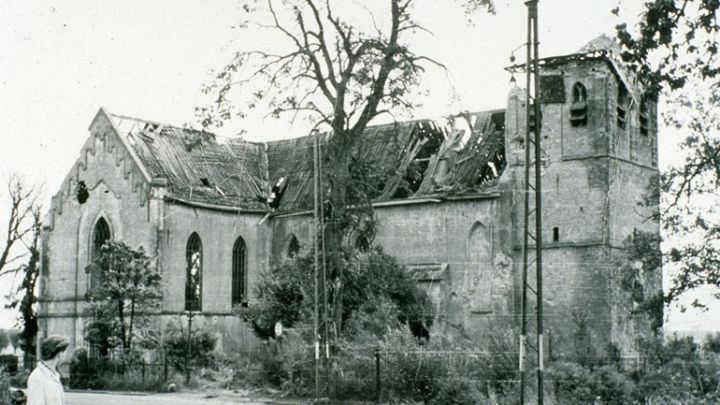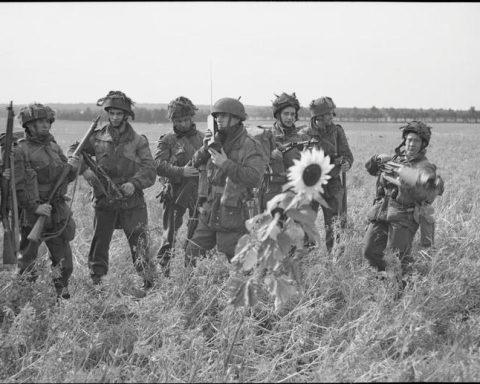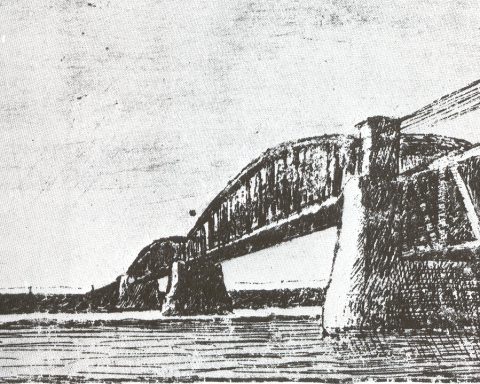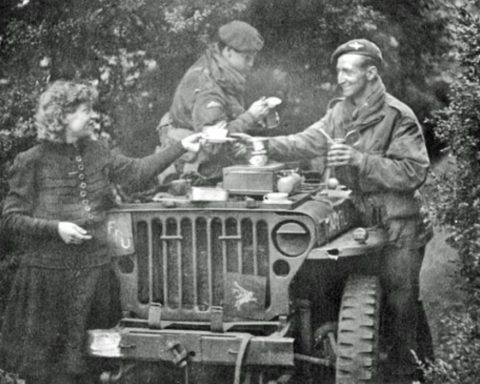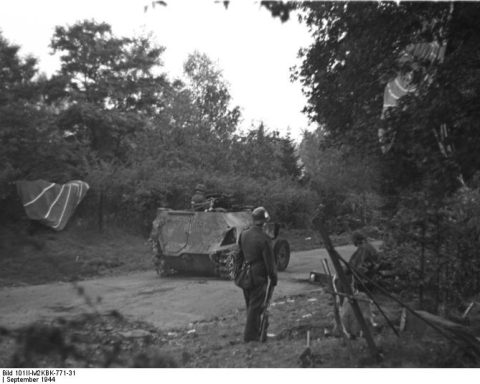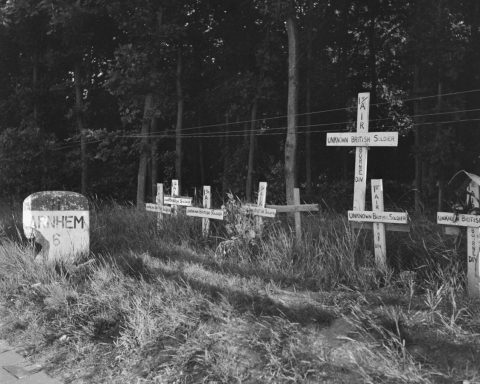The night of September 25 to 26 seemed to have been made to leave the British perimeter without the Germans realizing this. It rained all night, so sounds could not be heard. Due to the clouds there was no moon, making it very dark that night.
General Urquahart had chosen to leave a light screen of defense in the British positions during that night’s parade to prevent the Germans from realizing that the British were retreating. Only when most of the British had withdrawn across the Rhine would the last defenders also withdraw to the Rhine.
German prisoners of war
The British positions that night were mainly manned by Polish soldiers and a number of soldiers from the 4th Dorsets. The British army had a rule that soldiers who arrived last were also the last soldiers to leave. Thus, the soldiers who had reinforced the British positions from the south of the Rhine from Thursday, September 21, were given the task of covering the retreat.
A number of Military Police soldiers also stayed behind. They guarded the German prisoners of war who had been collected by the British on the tennis courts at Hotel Hartenstein. In total, the British had taken 200 German soldiers prisoner. To prevent the Germans from escaping that night to report the British withdrawal, they were guarded until early morning.
The rain and darkness helped to keep the retreat a secret from the Germans. But many British soldiers had great difficulty reaching the assembly point at the Oude Kerk in Oosterbeek in the dark. Some units were on the road for more than three hours.
Several soldiers were killed during the journey to the assembly point. In his book on the Battle of Arnhem, historian Antony Beevor quotes Lieutenant Bruce Davis:
“We walked along a road and behind hedges until we reached an open field held at gunpoint by a German machine gun. As we crawled along, there was suddenly a very bright light, but apparently they didn’t see us. We ended up in a forest again. We stopped to rest and as we crouched down, the man behind me fell forward on his face. I thought he saw something and took cover. But when I rolled him over, I saw that he was dead.”
At the church, each group of soldiers arriving was advised to lie down and wait until they were called forward for the crossing.
The Allies had arranged as many boats as possible for the retreat: 21 wooden storm boats with an outboard motor and ten canvas attack boats. There were also a few small rubber boats. The first boat launched at 9:30 PM. Even though it was dark, it was immediately fired upon by German troops on the other side. The boat was damaged to such an extent that it flooded and was otherwise unusable. The second boat was hit by a mortar shell during the crossing and sank.
Then one boat after another went to the other side to pick up the airborne soldiers. At 9:45 p.m. the first airborne soldiers reached the south bank near Driel.
The German positions on either side of the British perimeter in Oosterbeek were bombarded by guns from the 43rd Wessex Division to keep the Germans in their positions. But despite this, the Germans fired mortars and machine guns at the Allied boats on the river.
The evacuation of the British proceeded slowly, partly due to the German shelling. What didn’t help was that many of the outboard motors took in water and stopped, forcing the soldiers to paddle across with their hands and rifle butts.
During the night, more and more British airborne soldiers chose to try to swim to the other side of the Rhine. A number of soldiers insisted on taking their weapons with them, which made it difficult for them to swim. Many soldiers drowned as a result. The exhaustion after a week with little sleep and food also caused many paratroopers who tried to swim to the other side to be carried away by the current and drowned.
At first dawn, not all British airborne soldiers had been transferred to the south bank. This led to increasing unrest and panic among the British who were still on the northern bank of the Rhine.
Major Tucker, who headed the engineers who had to direct the crossing, later said in the book ‘ The Stormboat King ‘:
“Men panicked and stormed the boats, which in some cases capsized. In many cases they had to be knocked off to prevent the boats from sinking. They were so afraid that daylight would force us to abandon the crossing before they could be rescued.”
At 5:45 am that morning the order was indeed given to stop the evacuation. It was too dangerous for the boats and crews to continue crossing the Rhine. However, Lieutenant Russell Kennedy of the engineers ignored that order and sailed back and forth two more times. During his first crossing, five men were injured. During the second, virtually no one reached the other side unscathed and there were many fatalities.
The troops who had provided the perimeter defense evacuated their positions just before dawn. The Polish corporal Boleslaw Kuzniar wrote about the retreat to the Rhine:
“We passed a fallen tree on the way. There were the bodies of about thirty British soldiers. They were the men whose retreat we had covered. They must have been very tired that they did not realize that by crossing an open area they were an easy target for German machine guns. It was a horrible sight.”
However, by the time the Polish perimeter defenders arrived at the Rhine, it was already light. The evacuation had been stopped. Some soldiers took the plunge and swam across the Rhine, but most soldiers stayed behind on the northern bank of the Rhine. They were captured by the Germans later that morning.
Tea with rum
A barn had been set up near Driel for the exhausted and numb soldiers who had arrived safely on the south side of the river. There the airbornes received tea with rum, a plate of hot food and blankets to warm up.
For the swimmers who had taken off their clothing during the crossing, clothing was arranged from residents of Driel. Several soldiers walked around that morning in floral dresses.
The Polish soldiers who had crossed from Oosterbeek to Driel did not find any other Poles from the Polish Parachute Brigade there. General Sosabowski and his men had been ordered to Nijmegen. On foot. No transport was available for the Poles.
German response
German General Walter Harzer of the 9th SS Armored Division said after the war that the Germans did not realize until midnight that British troops were being transported from the perimeter.
“Shortly after dark on Monday, September 25, it was reported that a strong sound of engines could be heard coming from the south bank. Initially, the German commanders suspected that reinforcements
were being brought in for the British again. However, by midnight it became clear that units from the beachhead were crossing south in boats.”
Harzer had then tried to mount a German attack to ensure that the British would be denied access to the river. However, this happened too late and by the time the Germans were able to attack, the sun had already risen and the evacuation of the British had been halted.
Harzer: “At 9 o’clock the last British resistance was broken.”
2,163 soldiers
Of the approximately 11,000 British and Polish soldiers who had landed at Wolfheze at the start of Operation Market Garden, only a fraction had retreated across the Rhine during the night of Monday 25 to Tuesday 26 September.
That night, a total of 2,163 British and Polish soldiers reached the south side of the Rhine. This included 1,741 men from the British Airborne Division. In addition, 160 Polish paratroopers, 75 men from the Dorset Regiment and 422 glider pilots were also evacuated.
Many of the survivors were amazed that they had survived the battle. One of them was Lieutenant Hay. He stood on the street in Driel, while the Germans fired grenades at Driel from the north side of the Rhine. A captain of the 43rd Division shouted to Hay: “Don’t stand there! That is life-threatening.”
Hay: “I couldn’t help but laugh. It was the safest place I had been in over a week.”

